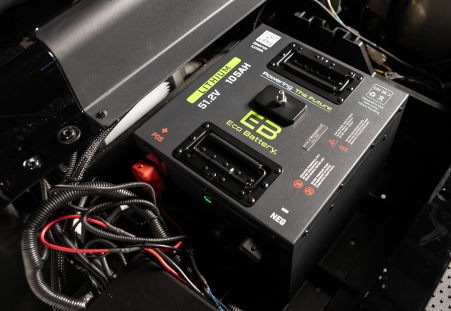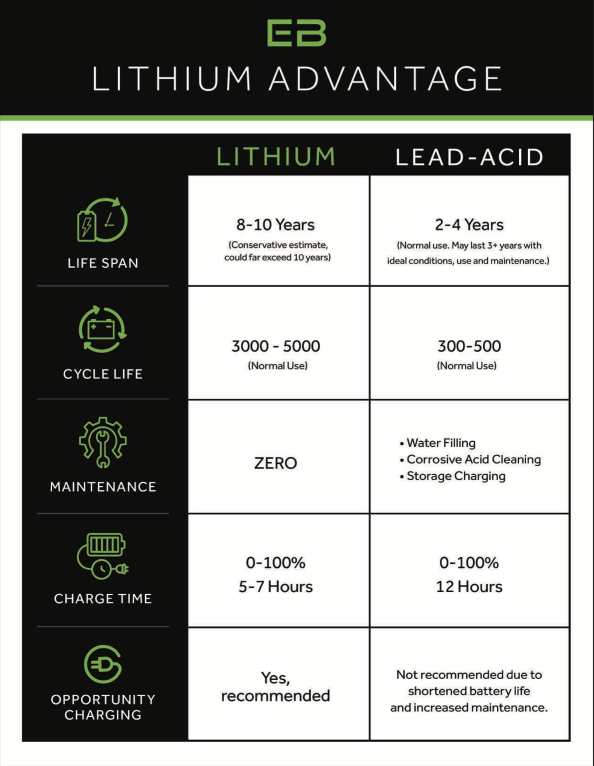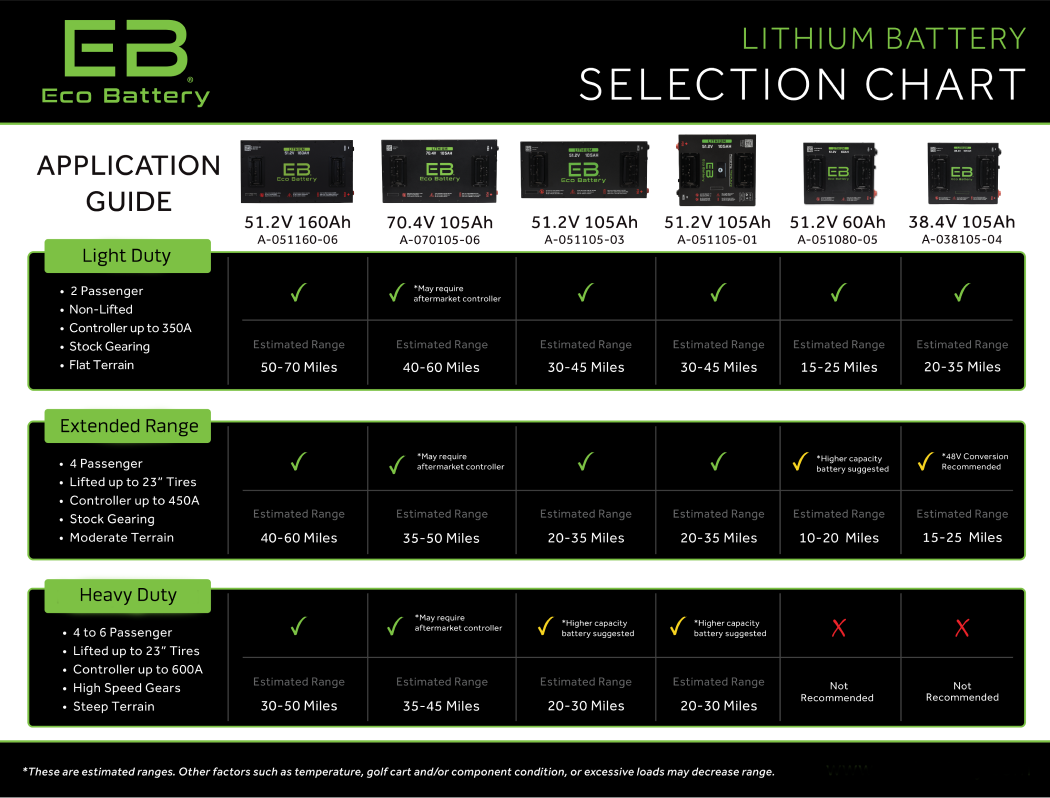Available 5 Days A Week! 1-888-444-9994
Where's My Order?


MY CART (0)
Cart Subtotal:
Are you undecided on switching to lithium? Still have questions about why lithium batteries are different from lead acid batteries? Hopefully we will be able to answer all your questions here. If you have even more questions, please feel free to reach out to one of our qualified phone customer service reps. We will get all your questions answered!
We will break all the information down for you into a couple of sections, this first one is about the differences between lead acid batteries and lithium batteries.


There are many benefits to lithium batteries vs lead acid batteries. For most people, the primary question comes down to having a larger investment up front in a lithium vs smaller (often more) investments over time with lead acid.
Let's break down some of those benefits, starting with the most obvious that goes into the investment decision which is about how long lithium batteries last vs lead acid batteries. On average a lithium battery lifespan will be 8-10 years which is a conservative estimate. After all the lithium batteries are backed by an 10-year warranty. A normal use lead acid battery has a 2-4 year lifespan depending on use condition and maintenance of the battery. Take that into consideration when calculating the cost difference between lead acid and lithium. Depending how much you get out of your lead acid batteries you will be replacing them between 2 to 5 times during the lifespan for a lithium battery. In terms of battery language, a lead acid battery gets between 300-500 charge cycles out of it while a lithium battery gets 3,000-5,000 charge cycles.
On top of the longer lifespan of a lithium battery they also have significantly less maintenance required. You won't have to add water on a regular basis, you won't have corrosive acid clean up or storage charging. Lithium batteries also have significant safety features built into their battery management system (BMS) that you won't find with a lead acid battery. Lithium batteries have a smaller footprint which allows for additional space under your seat, and they also weigh less.
We thought you'd never ask! Lithium batteries fully charge in less time than lead acid batteries AND they maintain their full storage capacity over 8 years while there is a massive 10-20% storage loss each year with lead acid batteries. You will be able to see estimated ranges per battery in the more detailed section about lithium batteries further down this page.
Still not convinced? Lithium batteries also have some environmental benefits because they last longer and are free from toxic chemicals.
Let's explore lithium batteries and their technology a bit further!
One of the main difference to lead acid batteries is that lithium batteries are not just a power source but also have a lot of technology and intelligence built into them that help manage your cart and the life of the battery. Next, we will cover features, specification, and benefits of the battery as well as the battery technology.

Construction:
The battery is inside a convenient and cleanly designed powder coated
steel case. Depending on the model it is IP65 or IP67 Rated. Those are both waterproof ratings, and
essentially state that the battery is rated for low pressure water jets from any direction as well as
condensation and water spray. An IP67 rated enclosure offers more substantial protection. These
batteries are suitable for most outdoor use. You will see in the owner’s manual that these batteries
should not be pressure washed. Beyond the waterproof rating the battery cases have 4 internal
temperature sensors and lifting handles for easy of install.
Lithium Components:
There are many different lithium batteries and they are not all
the same. For example lithium batteries in laptops and e-bikes use Lithium Polymer (LiPo) or Lithium Ion
(Li-Ion) cells which are much more prone to swelling, overheating, and thermal runaway. ECO batteries
only uses Grade A Lithium which is Automotive Grade-A Cells. ECO batteries use LiFePO4 cells which are
very stable and highly resistant to thermal runaway. Paired with additional safety measures we will go
over later the ECO lithium batteries are considered to be very safe batteries. There are no rare earth
elements or heavy metals used in the ECO batteries and use the safest lithium chemistry available.
LiFePO4 CELLS:
What makes ECO’s Lithium batteries so unique is the Battery Management System (BMS) and the Controller Area Network (CAN) communication protocol. The BMS is propriety software developed by ECO to control and manage the battery and systems it connects to. ECO’s batteries also have a Power Save Mode pioneered by ECO.
What does the BMS do?
The BMS has a lot of safety features built into it for battery
management. Here is a list of features and what they do:
That’s a lot of features to ensure the battery is managed safely and gets the best performance for your usage.
What is the Controller Area Network (CAN) and what does it do?
The controller area
network (CAN) is a communication protocol for the controller/motor, charger, and other accessories. By
being CAN enabled the battery (BMS) to directly communicate with the controller and motor. It can also
communicate with the battery charger to best manage the charge cycles of the battery. This is an
additional safety feature built in, the charger can adjust its output based on individual cells in the
battery, not just the entire battery pack. ECO Battery is the only lithium golf cart battery in the US
Market using CAN charging as of today. CAN communication also allows the BMS to directly integrate into
the cart’s drive system to manage battery draw as well as regeneration. The CAN network also allows for
communication to certain OEM display screens.
Power Save Mode:
The power save mode is a lot of intelligence built into the Battery
to protect your battery during storage. There are automatic timers with adjustable setpoints built into
the battery that will turn it off automatically. This provides convenience and protection of the battery
should you forget to turn it off. The default power save timers are set for the battery to turn off
automatically in 7 days without use if the battery has a charge % between 21% and 100%. The turn off
time is reduced to just 24 hours when the battery charge % is between 0-20%.
To summarize, an ECO lithium battery is not just a power source but an intelligent management system that optimizes performance by communicating with the charger and controller in your vehicle. It also has enhanced safety features built into it to reduce the risk of damaging the battery. Remember these ECO batteries are also covered by an 10-year warranty and a U.S. based support team.
What performance can I expect out of the lithium battery?
This is a science and an
art, but we will answer this question by guiding you into the best battery option for your use and
vehicle setup.
The first thing you should consider is if your cart is a 36V or 48V setup today. Depending on your voltage setup your controller and motor will have similar Voltage setups. You should choose a battery that supports that voltage so that you don’t have to upgrade your controller and motor. A 36V cart setup will take a 38V battery and a 48V setup will take a 51V battery. The 70V battery option may require an aftermarket controller upgrade.
The next decision is based on your vehicle configuration and your use case. You will want to size the right battery to your power demand to ensure you get the performance you are looking for from your power source. Things to consider here are 2,4, or 6 passenger vehicles, stock or lifted, size of your current controller, your gear ratio, and the terrain you drive on. To help with guiding you please see this fantastic selection chart with estimated ranges for each configuration and use case.

Some callouts for you regarding the information on this chart:
Once you have figured out which size battery you will want to purchase you can use the Make and Model selector on the battery page to find the bundle that best fits your vehicle.
What is included in a Lithium Conversion Kit?
Lithium conversion kits will have
everything you need to convert your vehicle from lead acid to lithium. There are 4 components to each
kit with the hardware required to secure the battery in the battery well changing depending on the
vehicle make and model.
Components to a Lithium Conversion Kit:
In true industry leading fashion Eco has made some incredible updates to their GEN3 battery system. Don’t be alarmed, the battery is still built off the same proven platform with the same Grade A, High Quality Lithium Cells.
The GEN3 batteries come with a new BMS (Battery management system). With it some new capabilities are unlocked to adapt to the ever-changing market. With increased performance in mind the battery system has a higher charge and discharge rating than before. This change allows for optimization with high performance controller demands. There is also a larger heatsink for cooler operating temps and higher loads. The new BMS also has improved cell balancing! New CAN protocols also allow increased aftermarket opportunities and greater integrations.
Not only did Eco have performance improvements in mind but also addressed some convenience improvements that will be new with the GEN3 batteries. Let’s start with the big improvement, bluetooth connectivity for BMS firmware updates! That means easy battery firmware updates with your phone, no longer any trips required back to the dealer. Secondarily, the new GEN3 battery bundles will come with a Remote Battery Wake-Up Kit. This is an additional switch that can be installed in the dash for convenient battery wake-up. Stop lifting that seat and using the switch on the battery. Additionally, the battery has remote key switch capabilities with specific key switches. Another improvement is automatic charger wakeup, no longer does it require user input, just plug it in and charge!
We are excited for all the feature and performance improvement in these new GEN3 batteries. Shop the full selection on our site!